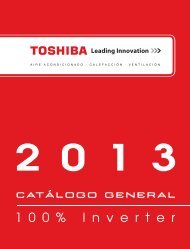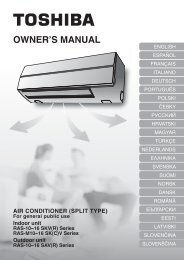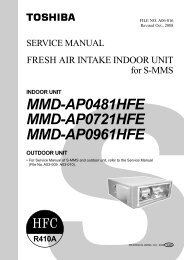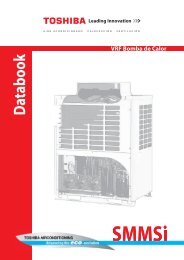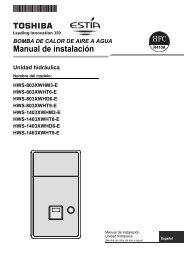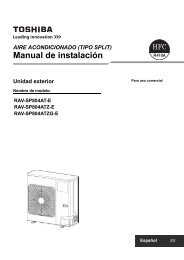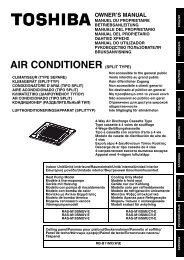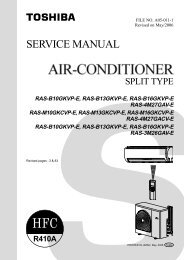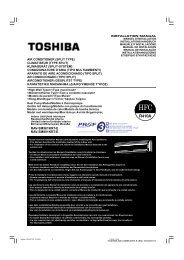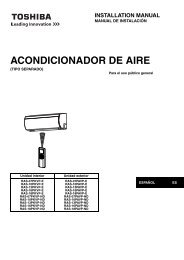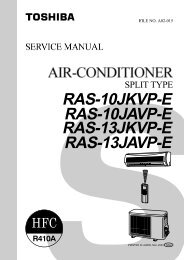MULTI TYPE
MULTI TYPE
MULTI TYPE
You also want an ePaper? Increase the reach of your titles
YUMPU automatically turns print PDFs into web optimized ePapers that Google loves.
11REPLACING COMPRESSORS<br />
11-1.Compressor Replacement Procedure (Outline)<br />
YES<br />
START<br />
Is the outdoor unit the only one in the system?<br />
Manually open PMV1, 2<br />
and 4 of the failed unit<br />
(by short-circuiting the<br />
pins of CN30 on I/F P.C.<br />
board and turning off the<br />
power switch), and<br />
recover refrigerant using<br />
a refrigerant recovery<br />
device (*1).<br />
NO<br />
Recover refrigerant<br />
from the failed unit in<br />
accordance with “10<br />
OUTDOOR UNIT<br />
REFRIGERANT<br />
RECOVERY<br />
METHOD”.<br />
Turn off the power switch of the failed outdoor unit.<br />
Dismantle the faulty compressor.<br />
Measure the amount of oil in the faulty compressor.<br />
WARNING<br />
In situations such as indoor unit relocation and repairs,<br />
it is not possible to recover all the refrigerant held by the<br />
system in the outdoor units.<br />
It could cause a serious accident, such as blow out or<br />
injury.<br />
Be sure to perform refrigerant recovery using a<br />
refrigerant recovery device.<br />
WARNING<br />
When detaching a pipe by heating with a burner a<br />
welded joint, take care as any oil left in the piping may<br />
burn in a momentary flash of fire when the weld filler<br />
metal melts.<br />
*1 The full-opening of PMV1, 2 and 4 via short-circuiting of the CN30<br />
pins is automatically undone after 2 minutes, causing the valves<br />
to fully close. To maintain fully open state, turn off the power<br />
switch of the outdoor unit within 2 minutes.<br />
*2 The SMMS-i (4 series) and the SMMS (3 series) use different<br />
types of compressors.<br />
Be sure to check the service part code.<br />
Check the color of the oil in the faulty compressor.<br />
ASTM grade: Is it 4 or above?<br />
(Judge the condition of the oil against color samples,<br />
and decide whether to replace the faulty compressor<br />
only or all compressors.)<br />
YES<br />
Replace both the faulty compressor and the normal<br />
compressor(s).<br />
NO<br />
Replace the faulty compressor only.<br />
Measure the amount of oil in the normal compressor(s).<br />
Adjust the amount of oil according to the oil quantity<br />
measurement result(s).<br />
Install the new compressor(s) (*2).<br />
Perform a leakage check of the failed outdoor unit.<br />
Perform vacuum drying in the failed outdoor unit.<br />
Refrigerant charging<br />
END<br />
This flowchart only shows the standard compressor<br />
replacement procedure. Since the situation can differ<br />
site by site, perform the task in accordance with the<br />
following judgment criteria:<br />
(1) New compressors are charged with 1900cc of oil<br />
per unit.<br />
(2) The amount of oil held by an outdoor unit is as<br />
shown below.<br />
MAP0804, 1004, 1204 MAP1404, 1604<br />
Amount of oil 4300cc 6700cc<br />
(3) When a compressor is dismantled, it usually<br />
contains 800-1400cc oil.<br />
The amount of oil held by an oil separator is usually<br />
0-1000cc for MAP0804, MAP1004, and MAP1204<br />
and 0-1500cc for MAP1404 and MAP1604.<br />
255



